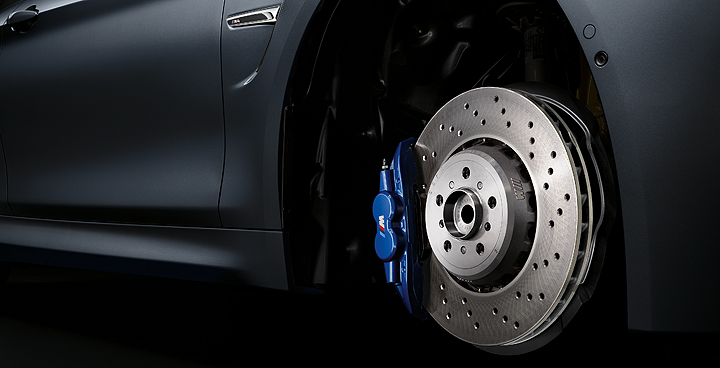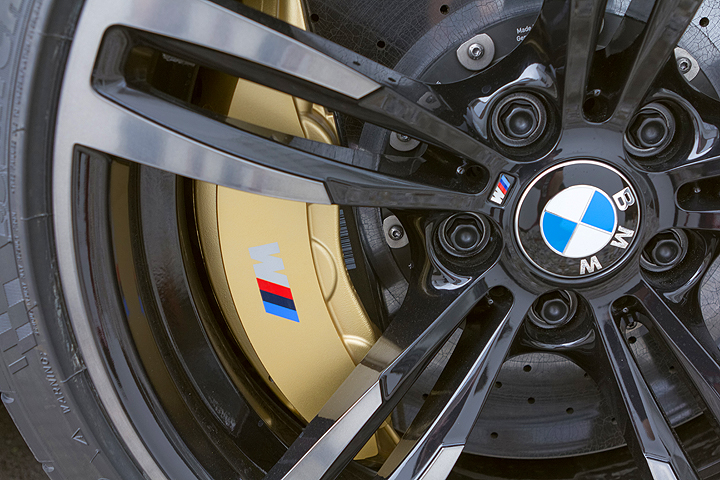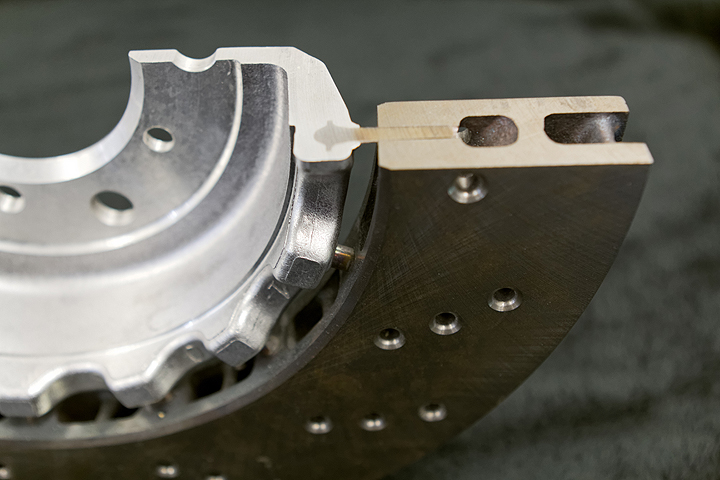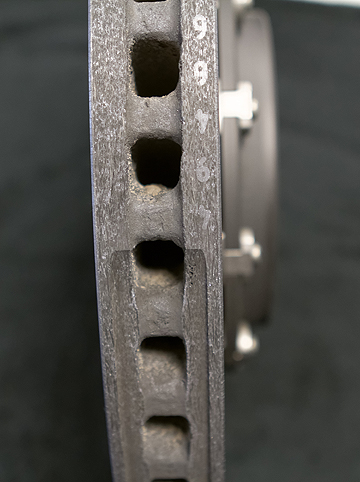Interview with M engineer Klaus Dullinger on the new brake system for the BMW M3 and M4
The BMW M3 and BMW M4 both feature a new type of brake system. Let us begin with the M compound brakes – what is special about them and in what ways do they differ from the M compound brakes installed in the previous model?
Klaus Dullinger: M compound brakes have a grey-cast friction ring in a floating arrangement that is connected by pins to the aluminium brake cover. The pin assembly means that as the temperature increases, it is able to expand freely in a radial direction and subsequently cool down again without any residual deformation. This connecting system has been in used since the second generation of the BMW M3.
What is different about the new BMW M3 and BMW M4 is that fixed-calliper brakes are now fitted to the front and rear axles, with four pistons at the front and two at the rear. The predecessor had heavy single-piston sliding callipers.
Is it necessary to allow M compound brakes a running-in period when the components are new?
Yes. Drivers should be more restrained in their driving for the first tank full of fuel and avoid maximum deceleration wherever possible.
What happens in these first 500 kilometers?
It concerns the so-called ‘bedding’ of the brake linking on the friction ring: it is necessary for the two surfaces to become adjusted to each other. Moreover, the 20 µm thick cross hatch of new brake discs wears away, which promotes the bedding of the new brake pad on the new disc.
Friction ring of the M compound brakes.
Why is it that with perforated brake discs in particular, you occasionally see slight cracks?
Cracks form in particular wherever relatively cold discs are suddenly subjected to a large load. The cracks that occur are limited to the surface areas. For instance, if you have been driving your car fully laden on the motorway for an extended period without braking and then you are suddenly called upon to perform an emergency braking manoeuvre, the brake disc will become very hot in a very short space of time – in such a case, the temperature can increase from around 20 degrees to 450 degrees. If the brake disc is required to perform in this manner several times in rapid succession, it is quite possible for surface cracks to form in the cast material of the friction ring – especially in the area around the perforation holes. In sports cars, cracks like these are, more than anything, a sign that they are being subjected to the use for which they were designed, and they have no negative effect on the service life of the brake disc or its braking performance. When it is time to change the brake pad, it is also necessary for the car dealer to inspect the brake disc.
Will racing pads again be available for the M compound brakes of the new BMW M3 and BMW M4?
Yes, a new sport pad will be available under the name of ‘M Performance Sport Brake Pad’; this was developed directly alongside the new brakes.
What are the advantages and disadvantages of these sport pads?
The life expectancy of these pads is considerably longer at the kinds of high temperatures that typically occur on the racetrack. While the standard pad can display a drop in friction coefficient at high temperatures, known as fading, the friction coefficient value of sport pads is far more stable.
In general, operational noise can be generated with any high-performance brake under certain driving conditions. However, with sport pads, we do without any form of comfort factor in the car components, which means that considerable braking noise is simply a fact of life for people who choose to use them.
Sport pads are more expensive and act considerably more fiercely on the brake discs. Disc wear is several times higher than that of standard brake pads. Which is why we require that every time a set of sport pads is fitted, new discs also have to be installed. For this reason, we will be offering sport pad kits, consisting of the actual pads plus the required brake discs.
Why is it so important to perform a cooling-down lap after driving on the racetrack?
It is very important for the material in the brake components to have time to cool down in an air stream. If you park your car while temperatures of 500 degrees are still prevailing on the brake discs, the considerable heat will be transferred throughout the entire brake system. And the brake pads too will absorb energy from the hot brake discs. The heat transfer progresses through the back plate and damping plates of standard pads into the brake callipers. In addition to the damping layer of the damping plates, the piston seals and dust shields can also be damaged, as can the surface coating of the brake callipers. Leaving brakes to cool in a stationary position is extremely unfavourable when brake discs are at a temperature of up to 500 degrees. By performing a cooling-down lap, the brake temperature generally falls to below 200 degrees.
Do such high temperatures occur in normal driving conditions?
No, normally such temperatures do not occur when subjecting a vehicle to normal use. It would be necessary to perform several braking manoeuvres in rapid succession, from full speed to stationary, before such levels would be reached.
M Carbon Ceramic Brakes.
Friction ring of the M compound brakes.
M carbon ceramic brakes are also available for the first time for the new BMW M3 and BMW M4. What are the advantages of these brakes?
The rotating masses in M carbon ceramic brakes are around 12.5 kg lighter compared with standard M compound brakes.
On the other hand, these brakes are dimensioned to offer significantly more in terms of performance. In other words, instead of 18“ M compound brakes, we fit 19“ M carbon ceramic brake discs. We deploy a six-piston calliper on the front axle and a four-piston fixed-calliper brake on the rear axle. The operational surfaces of the brake pads are appreciably higher. This means that the M carbon ceramic brake offers a considerable advantage in terms of performance. So on the racetrack in particular, the M carbon ceramic brake offers more stability.
A further advantage is that the disc is not so susceptible to corrosion, which means that no rust films form on the friction ring, a phenomenon that is well known in grey-cast constructions.
With conventional brake discs, corrosion is more likely to occur with low mileages, long idle periods and low usage, because the minimum load level required to initiate the disc brake’s self-cleaning mechanism is not attained. Corroded brake discs generate a rubbing effect when the brakes are applied, which in the majority of cases can no longer be removed.
However, this does not occur with M carbon ceramic brakes, since they do not have a problem with corrosion.
Already in new condition – due to the different material compositions of friction layer and disc body – the friction surfaces are covered wih an distinctive stress reliving structure.
Furthermore, they are less subject to wear. The brake pads wear more slowly, and under normal use, the carbon ceramic brake disc will last as long as the car itself; the silicon carbide friction coating is virtually non-wearing. However, on the racetrack, the brake discs may be subject to oxidative wear. When the discs are repeatedly heated to temperatures of 600 degrees and over, the fibres within the brake disc burn up.
This means that the disc does not become progressively thinner but lighter. To detect the level to which this may have occurred, three wear indicators per friction coating are applied to the disc, set apart at angles of 120 degrees. This allows the dealer to recognise when discs have been subjected to high levels of oxidative wear. The brake pad service team then takes out the brake disc and weighs it. If it weighs less than the minimum permitted weight, the disc must be replaced.
Are there any disadvantages with carbon ceramic brakes?
The production process is much more complex. One step involves siliconising the friction ring for a period of 24 hours at 1,300 degrees.
The carbon fibre-reinforced silicon-carbide brake disc has a total throughput time of several weeks with the manufacturer before it is ready.
This explains why the purchase price of the M carbon ceramic brake is that much higher. However, this is partly balanced out by the lower level of wear.
This system does have a number of special characteristics, of which you should be aware:
Brake discs and brake pads in M carbon ceramic brakes only achieve a favourable wear and contact pattern after around 1,000 km.
Material-specific properties mean that increased operational noise may be experienced when braking, particularly in wet conditions, just before the vehicle comes to a halt. However, this does not affect the brakes’ performance, operational safety or stability.
It is a good idea to clean both brake discs and callipers with a steam jet or high-pressure cleaner before putting the vehicle through an automatic car wash or washing bay facility, to avoid the formation of encrustations or deposits of, for example, salt crystals, when the car stands stationary after cleaning. The cleaning effect of such automatic washing systems in the vehicle’s wheel areas is generally not sufficient to ensure this. As with all brake systems, it is important to ensure that any rim cleaner used is only applied to the wheel rims.
If the brake disc and pads become wet, all brakes undergo a drop in their friction coefficient. M carbon ceramic brakes normally have a considerably higher coefficient of friction than conventional brakes, and they feel considerably fiercer in operation. However, under the impact of moisture and road salt, for example after using a car wash, or when condensation has formed overnight, the braking effect may be equivalent to that of a conventional brake system. This may be perceived as reduced braking performance, but it can be compensated for by applying more pressure with the brake pedal; this should be continued until the pads and discs have fully dried out. Since the difference in frictional coefficient between dry and wet brakes is higher than normal with M carbon ceramic brakes, it is felt all the more clearly by the driver.
Which brakes would you personally choose?
The M compound brakes are fantastic but the M carbon ceramic brakes offer even higher performance. I would personally go for the M carbon ceramic brakes, despite the higher price.
[Source: M-Power]










































































